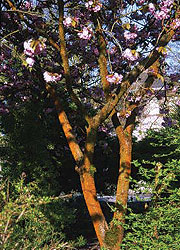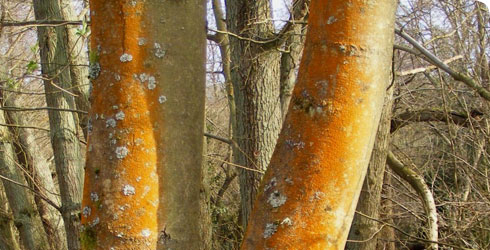Distribution
This is a cosmopolitan species that is widely distributed in temperate and tropical regions.

Orange colouration caused by Trentepohlia abietina growing on the trunk of a cherry tree in the campus of the National University of Ireland, Galway © M DGuiry and F Rindi
Orange-coloured algae - principally Trentepohlia abietina - were included in the 2009 Open Air Laboratory (OPAL) survey of lichens in England. The findings indicate this species is more widespread than previously thought.
Some records in the survey might be of Trentepohlia umbrina.This also grows on bark although it forms reddish rather than orange patches and these are hard and crust-like rather than soft and felt-like as in T. abietina.
The alga is most conspicuous on trees trunks in more weather-exposed situations in regions with humid climates.
It is also found on large limestone rocks in well-shaded habitats in deciduous forests along the east and south-western coasts of Ireland.
The genus Trentepohlia is the second most common algal component of lichens.
Habitat
Trentepohlia abietina is found more commonly in the wetter and more humid westerly parts of the British Isles on the bark of trees such as:
- cherries (Prunus sp.)
- beech (Fagus sylvatica)
- sycamore (Acer pseudoplatanus)
- ash (Fraxininus excelsior)
It is also found on woodwork in humid places, and occasionally on large shaded rocks in woodlands and the wetted rocky banks of rivers.
